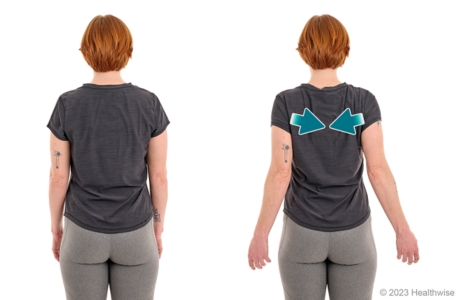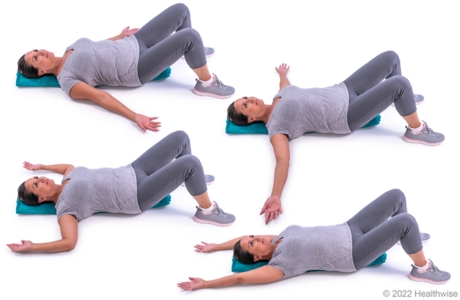Introduction
Here are some examples of exercises for you to try. The exercises may be suggested for a condition or for rehabilitation. Start each exercise slowly. Ease off the exercises if you start to have pain.
You will be told when to start these exercises and which ones will work best for you.
How to do the exercises
Chin tuck

slide 1 of 3
slide 1 of 3, Chin tuck,
- Roll up a towel so it is about 2 to 3 inches thick.
- Lie on the floor and place the rolled towel under your neck. Your head should be touching the floor.
- Gently nod your head, bringing your chin toward your throat. Be sure to keep the back of your head on the floor.
- Hold for about 6 seconds.
- Repeat 8 to 12 times.
Shoulder-blade squeeze

slide 2 of 3
slide 2 of 3, Shoulder-blade squeeze,
- Sit or stand up straight with your arms at your sides.
- Keep your shoulders relaxed and down, not shrugged.
- Squeeze your shoulder blades down and together.
- Hold for about 6 seconds, then relax.
- Repeat 8 to 12 times.
Chest and shoulder stretch (4 positions)

slide 3 of 3
slide 3 of 3, Chest and shoulder stretch (4 positions),
- Lie on your back with your knees bent and your feet about hip-width apart.
- Tuck your chin, and relax your shoulders with your arms at your sides.
- Hold this position while you move your arms into the following positions:
- Hold each arm position for 15 to 30 seconds.
- Repeat the entire cycle of arm movements 2 to 4 times.
- If you don't feel a mild stretch in your shoulders and across your chest, use a foam roll or tightly rolled towels under your spine, from your tailbone to your head.
- Make sure that your head and tailbone area are supported with the roll of towels or on the foam roll. Be sure the roll is in line with your spine.
- Arms down at your sides, with the palms facing up.
- Arms out to your sides in a T shape.
- Arms out to your sides with your elbows bent to 90 degrees, as in a goalpost shape.
- Arms stretched over your head.
Current as of: July 17, 2023
Author: Healthwise Staff
Clinical Review Board
All Healthwise education is reviewed by a team that includes physicians, nurses, advanced practitioners, registered dieticians, and other healthcare professionals.

